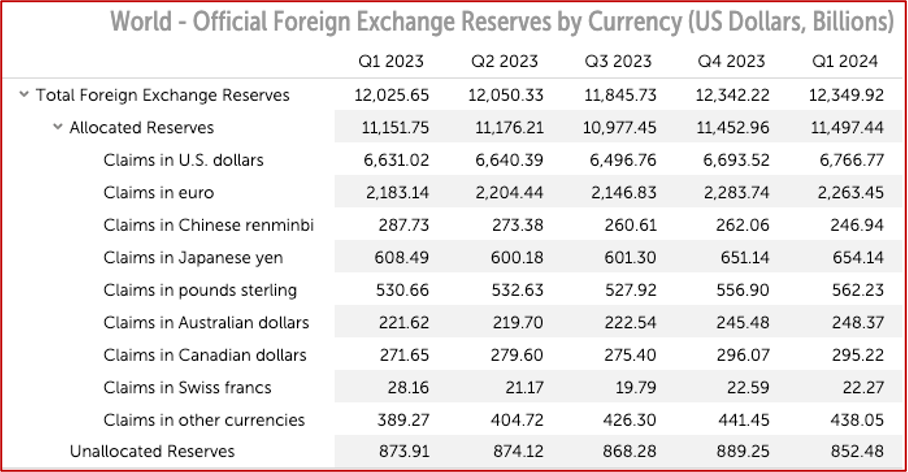DOLLAR RESERVE DISCREPANCY: EUROPE & US DIVERGENCE, Part 2
A guest piece by Owen Reynolds of Teklas Ventures, the venture arm of the FO associated to Teklas.
This piece is a guest piece written by our good friend Owen Reynolds from Teklas Ventures, the VC arm of a family office associated with Teklas.
Owen is an armchair economist and leads Teklas Ventures, the venture arm of an automotive family office, covering both venture fund investment and direct industrial tech investment strategies. He is a former US Peace Corps Volunteer, founder of a sustainable construction company, and economist at the US FERC. After his MBA, he started in impact investing at an Omidyar fund in the US, then spent two fund cycles with Expon Capital in Luxembourg.
One of the hidden differences between the US and Europe is the fact that the US dollar remains the world’s reserve currency. Yeah, “duh”, you may say. But the impacts on the tech world are dramatic—and there’s no way to replicate it.
I’ll admit that “Dollar Reserve Discrepancy” is not something you’ll find in the economics text books. But “the USD reserve status-derived mismatch between US productivity and derived value, leaving only uber-productive sectors reflective of the US dollar” sounded too long for the name of a post.
Reserve Currency
First, the facts. The Euro has given us a good “run for our money”, though the USD remains the world’s undisputed predominant reserve currency.
The International Monetary Fund publishes a quarterly report aptly named Currency Composition of Official Foreign Exchange Reserves. As of Q1 2024, the USD represents 58,85% of the world’s allocated foreign exchange reserves. The Euro comes in a distant second at 19,7%. A full table is below:
How the USD gained this place in history is worthy of reading—especially if you think fondly of the days when currency was linked to hard metal. Gold has indeed has a fairly sharp rebound since the Covid Pandemic, but it isn’t in the running for a reserve value any time soon.
The USD has also taken a fairly substantial tumble in recent years as Euros, Renminbi (esp. in Russia of late), and maybe even Bitcoin have increased in influence. Despite that move, there’s a tipping point which has not been reached to dethrone the dollar.
The USD’s reserve status began even before the 1944 Bretton Woods Conference. The decades that followed, the US was exporting into a global manufacturing vacuum, boosting the manufacturing sector and the dollar at once.
The question for today is what that reserve currency dominance has done to the US since the world’s manufacturing sector has regained competitiveness.
Dutch Disease
One of the most important repercussions for the tech industry reminds me of the “Dutch Disease”.
As you economics nerds may recall, and the name implies, this economic phenomenon was first identified after massive natural gas reserves were found in the Netherlands in 1959, and subsequently tapped. While revenues increase in a growing sector like petroleum products, for example, the nation’s currency appreciates relative to other currencies.
The result is that other (aka non-petroleum product) segments of the economy becomes relatively less competitive. The manufacturing sector in the Netherlands all but dried up in the decades following the natural gas boom. The Economist coined the term in 1977, and later renamed it the Paradox of Plenty, and is generally reserved for petro-states or occasional other highly concentrated economies.
The world’s USD reserve holdings act in a similar way. Countries relatively deflate their own currency valuations by holding USD reserves, boosting the USD’s relative value. In this case, there is no single segment of the economy to point fingers at, though the currency no longer reflects the nation’s productivity all the same.
Relative Productivity
A currency generally reflects the productivity of its population, divided by however many units of currency there are. But when “productivity” is inflated by a lucky strike, as in the case of the traditional Dutch Disease, it drowns out the rest of the economy.
The dollar faces the same imbalance. The USD has an inflated value partially because of being held in foreign reserves in such quantity. As in the Netherlands in the 1960s and 1970s, such a Paradox of Plenty results in an uncompetitive manufacturing sector.
As the world’s manufacturing sector expanded, the US could no longer sell its wares in an inflated currency. Europe rebuilt its manufacturing sector in the decades after WWII. Emerging economies (China in particular) became powerhouses in their own rights. US manufacturing could no longer sell at a premium, and the USD no longer reflected the true level of productivity of its population.
The Tech Switch
Fortunately, the United States had a well-educated population capable of overcoming this hurdle.
That relatively overvalued dollar could have either sent the US economy into a downward spiral, or tilt it slightly to those segments that accurately reflected the value of labor and national productivity. The few sectors who could justify the premium became the true winners.
Biotech firms, deep tech, computers, and science-driven firms led the way. Early on, Intel, Xerox, and Polaroid set the stage. In the 1970s and early 1980s a host of companies like Apple, Microsoft, and Amgen filled any remaining economic gap from a declining manufacturing sector.
A wave of innovators followed, such as Google, Amazon, Astra Zeneca, and Novartis, shifting the US’ future economy even more heavily into tech and biotech. The snowball grew into Tesla, Netflix, AbbVie, and Silicon Valley’s bench.
The common denominator across all these firms is that they are uber-productive per capita. They are defined by non-linear returns to additional capital invested. Additional productivity per capita, sparked by the dollar reserve discrepancy. The US’ public markets are now so heavily tilted towards these high productivity segments, it is actually impossible to go back.
Implications for Manufacturing
One of the things that economics and policymakers have argued for decades is why the manufacturing sector has seen such a drop off.
I would argue that the dollar reserve currency launched this ever-deepening tilt towards tech. It started the structural barrier that cannot be waved away by anything less than fundamental shifts to the US geopolitical and economic policy.
One of the same reasons that tech and biotech have become dominant forces in the US economy at a faster pace than anywhere else in the world, is the reason that manufacturing en masse cannot simply be “brought back” to America.
As Europe’s economy moves ever more into the tech sector, some of the same snow-ball effect may occur. Increased productivity options makes relatively less productive industries all that less attractive investment targets, uses of capital, and employers.
Tech Competitiveness
The tech and biotech sectors of the US have a relative advantage. That advantage is simply that other segments cannot reflect the inflated value of the USD. This isn’t a policy anyone can replicate, and I can’t imagine a fix for it either.
Valéry Giscard d'Estaing and Charles de Gaulle pointed to the “exorbitant privilege” that the USD reserve currency offered the country—the ability to borrow cheaply. And Ben Bernanke lamentingly wrote that “the exorbitant privilege is not so exorbitant any more” in 2016 as borrowing prices converged.
What they all missed was not what it meant for the price of debt, but what it would mean for the price of equity. External dollar holdings left the US tilted towards extreme productivity and paved the way for tech sector dominance.
This is part of a series on the divergence of the EU and US economies and the impact on innovation and startups from one investors perspective. Feel free to read Owen's previous post on Culture here.





